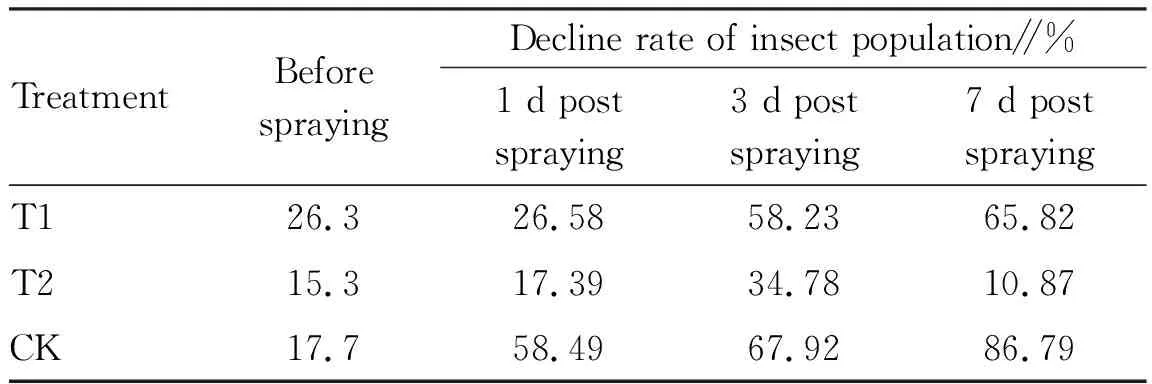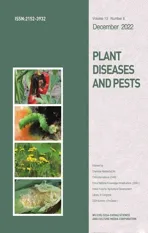Applied Technology of Botanical Pesticides against Empoasca pirisuga Matumura
2022-02-17XunCHENJingfengZHANGChaoHUANGRongrongTANDanjuanHUANGHongjuanWANGGaixiangLEIYoupingWANGJiongWUXianZHANGYingxinMAO
Xun CHEN, Jingfeng ZHANG, Chao HUANG, Rongrong TAN, Danjuan HUANG, Hongjuan WANG, Gaixiang LEI, Youping WANG,, Jiong WU, Xian ZHANG, Yingxin MAO*
1. Institute of Fruit and Tea, Hubei Academy of Agricultural Sciences, Wuhan 430209, China; 2. Hubei Baimi Biological Industry Co., Ltd., Xianning 437100, China; 3. Chibi Agricultural and Rural Bureau, Chibi 437300, China; 4. Yingshan County Public Inspection and Testing Center, Huanggang 438700, China; 5. Chibi Zhaoliqiao Tafeng Tea Co., Ltd., Chibi 437399, China
Abstract [Objectives] The paper was to explore the control effects of different botanical pesticides against Empoasca pirisuga Matumura. [Methods] 5% Eucalyptol SL, 0.5% matrine SL and 50% thiacloprid WDG were used to control E. pirisuga, and the decline rate of insect population was investigated. [Results] Eucalyptol had good control effect on E. pirisuga, with slow effect but long duration. It was harmless to natural enemies in tea gardens, with high safety and no chemical injury. [Conclusions] The study provides a theoretical basis for the application of botanical pesticides in tea production.
Key words Empoasca pirisuga Matumura; Control; Botanical pesticide; Chemical injury; Technology
1 Introduction
Tea leafhopper,EmpoascapirisugaMatumura, is a harmful and important pest in tea garden, and it is distributed in tea producing areas throughout China. The pest sucks the sap of new shoots of tea trees, and interferes with normal transport of nutrients, resulting in red brown, scorched and withered leaves[1]. The loss of summer and autumn tea caused by the pest reaches 10%-15% in general years and is more than 50% in severe years, and the pest seriously affects the yield and quality of tea[2]. The use of chemical pesticides will lead to such ecological problems as pesticide residues in tea, harming natural enemies and insect resistance. It has become the development direction of pest control in tea gardens by following the development requirements of ecological tea gardens and adopting green integrated control technology measures such as agriculture, biology and physics. In recent years, researches on monitoring and control techniques ofE.pirisugahave been extensively carried out in tea gardens in China[3], mainly focusing on color board trapping[4-6], while few efforts have been dedicated to botanical pesticides. By comparing the effects of different botanical pesticides onE.pirisuga, the botanical pesticides suitable for green control ofE.pirisugain Mufu Mountain tea area in southeastern Hubei Province were screened, so as to provide a reference for tea production and management.
2 Materials and methods
2.1 MaterialsThe botanical pesticides, 5% eucalyptol SL and 0.5% matrine SL, were provided by Beijing Yagenong Bio-Pharmaceutical Co., Ltd., and the chemical pesticide, 50% thiacloprid WDG, was provided by Hebei Guanlong Agrochemical Co., Ltd.
2.2 Experimental siteThe test was carried out in Yisiyuan tea garden in Guanbu Village, Guanbuqiao Town, Xian’an District, Hubei Province, 29°54′33″ N, 114°19′57″ E. It is a mountainous and hilly landform tea garden with good natural environment conditions and medium soil fertility. Tea trees in the garden were slightly pruned once from late May to early June in 2021. The planting management and soil fertility around the experimental site were consistent, and all tea trees were in good growth. The tea variety was Fuding Dabai, and all trees of the same age were under uniform growth.
2.3 Experimental designThree treatments were set up in the test: treatment 1 (T1), 4 666.67 m2, treatment 2 (T2), 4 000 m2, conventional control (CK), 2 466.67 m2. The treatments were sequentially arranged, and the specific settings are shown in Table 1 and Fig.1. All agents were sprayed on July 17, 2021.

Table 1 Experimental design of agents

Fig.1 Planning area of the test
2.4 Survey methodsThe insect population density in the field was investigated in each treatment area of the test. When the morning dew was not dry,E.pirisuga, spiders and ladybugs were sampled by basin-patting method. Three rows were randomly selected from each treatment as fixed investigation rows, and 10 basins were investigated in each survey row. During the investigation, a water basin with a diameter of 33 cm was placed under a tea tree to pat the surface of tea canopy for 5 times. After patting, the number ofE.pirisuga, spiders and ladybugs in the basin was counted immediately. After counting, the water basin was emptied and moved to the next location for patting, with an interval of 2-3 m.
Each treatment was investigated before spraying, and at 1, 3 and 7 d post spraying. The decline rate of insect population was calculated, which represented the control effect.
Decline rate of insect population=(Number of insects before treatment-Number of insects after treatment)/Number of insects before treatment×100
2.5 Data analysisDuncan’s new multiple range method was used to analyze the significant difference of control effect.
3 Results and analysis
3.1 Control effects of botanical pesticides onE.pirisugaAs shown in Table 2, 5% eucalyptol SL 300 times dilution had a good control effect onE.pirisugaat 3 d post spraying, and the decline rate of insect population reached 8.23%; the control effect increased at 7 d post spraying, and the decline rate of insect population was up to 65.82%, indicating that eucalyptol had a good quick and persistent effect onE.pirisuga. 0.5% Matrine SL 300 times dilution received the best control effect at 3 d post spraying, and the decline rate of insect population was 34.78%, indicating that matrine had certain control effect onE.pirisuga, but with short duration. These two types of botanical pesticides can be mixed in production to improve the control effect.

Table 2 Control effects of botanical pesticides on Empoasca pirisuga
3.2 Effect on natural enemies in tea gardenAs shown in Table 3, 5% eucalyptol SL 300 times dilution and 0.5% matrine SL 300 times dilution were less lethal to spiders in the tea garden, with higher safety. The number of spiders was small within 3 d after two botanical pesticides were sprayed, which probably attributed to the impact of rainfall on the survey day. 5% Eucalyptol SL 300 times dilution and 0.5% matrine SL 300 times dilution were highly safe for ladybugs in the tea garden, and the number of ladybugs increased after spraying (Table 3).

Table 3 Effects of botanical pesticides on natural enemies in tea garden
3.3 Chemical injury to tea gardenAs shown in Table 4, neither of the two botanical pesticides led to chemical injury.

Table 4 Chemical injury of botanical pesticides to tea garden
4 Discussion
The control effects of 5% eucalyptol SL 300 times dilution onE.pirisugareached 26.58% at 1 d post spraying, 58.23% at 3 d post spraying, and 65.82% at 7 d post spraying. Eucalyptol had good control effect onE.pirisuga, with slow effect but long duration. The control effects of 0.5% matrine SL 300 times dilution were 17.39% at 1 d post spraying, 34.78% at 3 d post spraying, and 10.87% at 7 d post spraying. The results demonstrated that matrine had certain control effect onE.pirisuga, but the effect was poor. The conventional control agent had good quick and persistent effects.
According to the survey results of native natural enemies in the tea garden, eucalyptol and matrine had less lethal effect on spiders and ladybugs in the tea garden, with high safety (it was raining on the survey day at 3 d post spraying, and small number of natural enemies may be related to the weather). Conventional control agent had less lethal effect on spiders and stronger lethal effect on ladybugs. The survey results of chemical injury showed that neither eucalyptol nor matrine led to chemical injury. In conclusion, in the tea areas whereE.pirisugaoccurs seriously, it is recommended to use the botanical pesticide 5% eucalyptol for biological control.
杂志排行
植物病虫害研究(英文版)的其它文章
- Preparation and Characterization of Nano-ZnO Precursor for the Antibacterial Activity against Thielaviopsis paradoxa
- Characterization of Neopestalotiopsis clavispora, A New Etiological Agent of Leaf Spot Isolated from Banana
- Whether the Microemulsion is a Nano-pesticide: Exploration from the Perspective of Particle Size and Morphology
